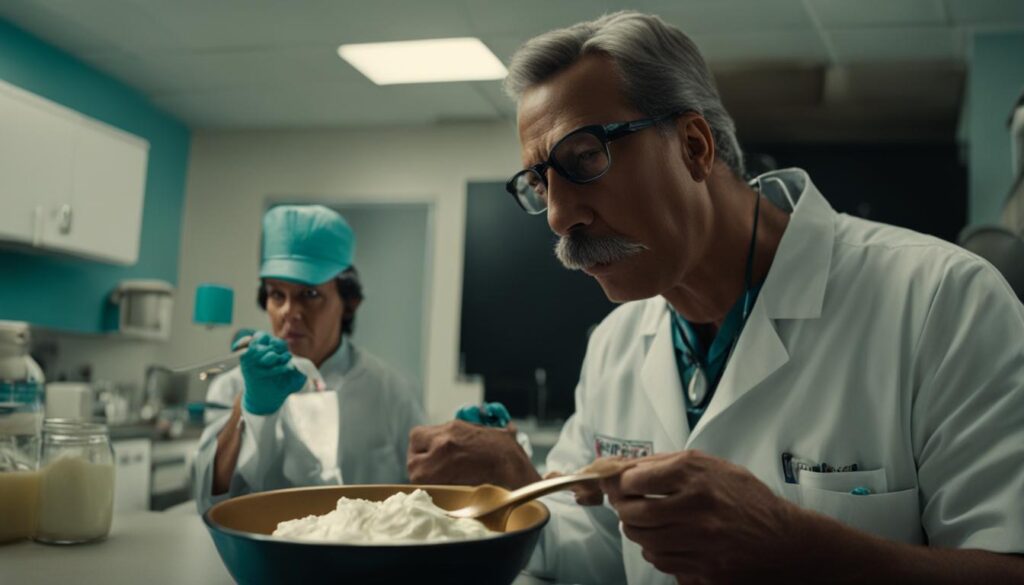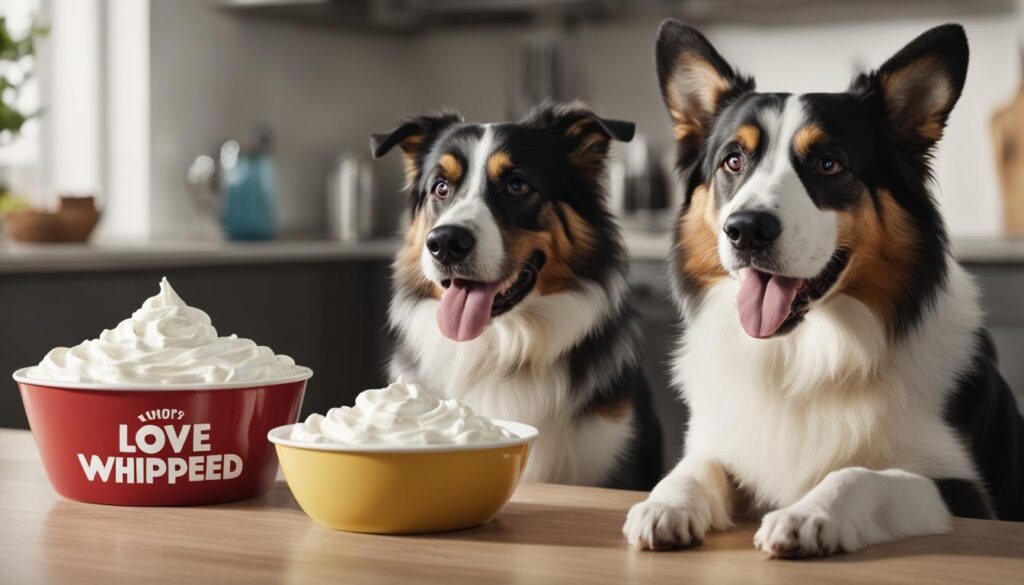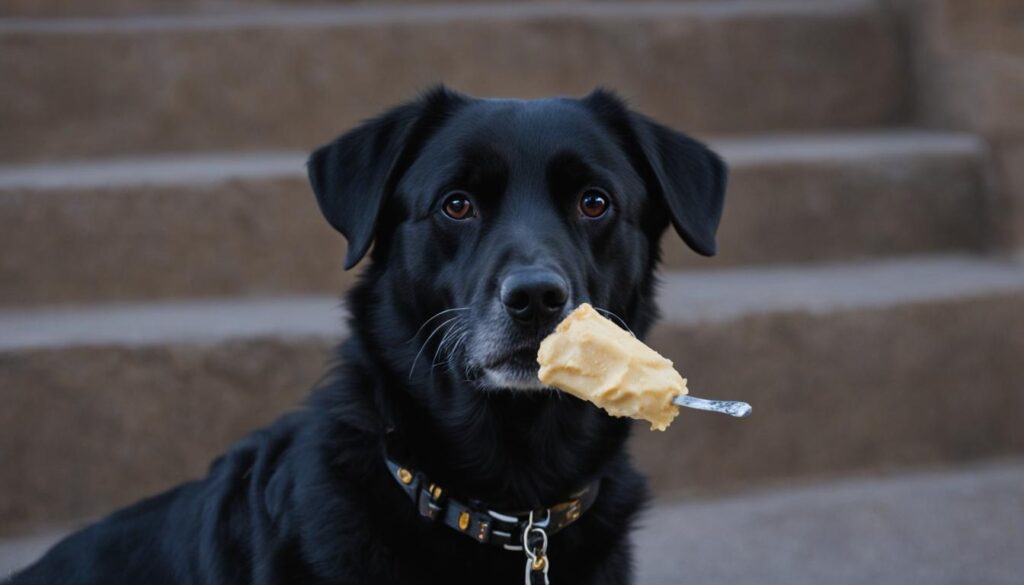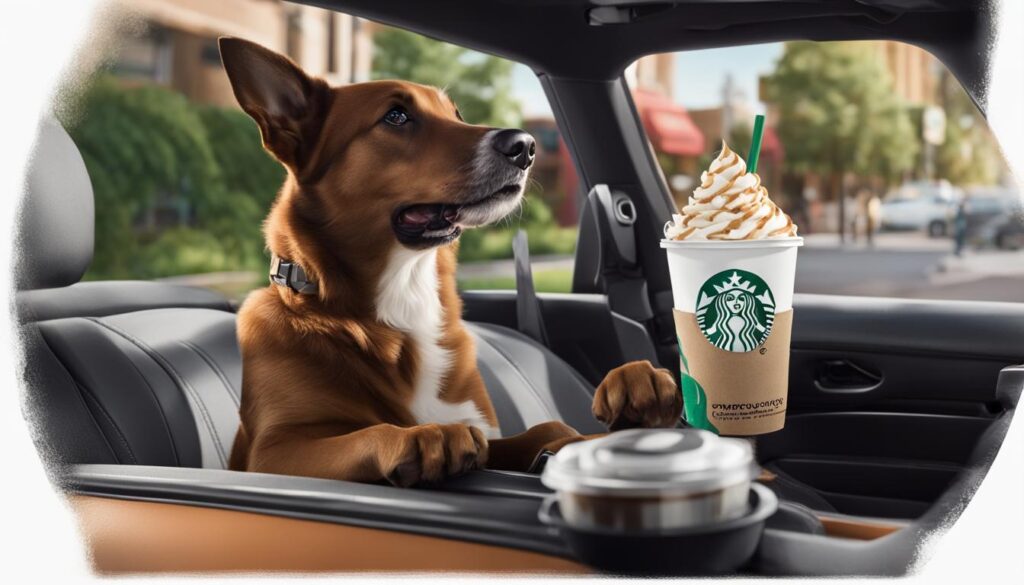When it comes to treating our furry friends, it’s important to know what foods are safe and healthy for them. One popular question among dog owners is whether dogs can have Cool Whip. Cool Whip is a creamy and delicious topping that many of us enjoy on desserts. But is it safe for our canine companions? Let’s explore the topic with insights from veterinary experts.
Key Takeaways:
- Dogs can have whipped cream, including Cool Whip, in moderation.
- Commercial brands of whipped cream may contain xylitol, which is toxic to dogs.
- Whipped cream should be given as a special treat and not a regular part of a dog’s diet.
- Dogs who are overweight, lactose intolerant, have gastrointestinal issues, or diabetes should avoid whipped cream.
- Alternative treats like plain yogurt, unsweetened whipped cream, or frozen fruit purees can be offered to dogs instead of Cool Whip.
The Safety of Whipped Cream for Dogs

Whipped cream, including Cool Whip, is generally safe for dogs to consume in small quantities. However, it’s important to note that some commercial whipped cream brands may contain xylitol, which is toxic to dogs. It’s best to make whipped cream at home to ensure it does not contain any harmful ingredients. Whipped cream should be considered a special treat for dogs and should not be a regular part of their diet.
While whipped cream can be enjoyed by some dogs, it’s crucial to be cautious about the ingredients in commercial brands. Xylitol, a common sweetener used as a sugar substitute, is toxic to dogs and can cause a severe drop in blood sugar levels. Some potential symptoms of xylitol poisoning in dogs include vomiting, lethargy, loss of coordination, seizures, and even liver failure.
To ensure the safety of whipped cream for dogs, it’s best to make it at home using simple ingredients like heavy cream and vanilla extract. By preparing homemade whipped cream, dog owners can have control over the ingredients and avoid any potential harmful additives.
While whipped cream can provide a creamy and delicious treat for dogs, it’s essential to remember that moderation is key. Just like any rich and high-calorie food, excessive consumption can lead to weight gain and other health issues in dogs. Therefore, it’s important to offer whipped cream as an occasional indulgence rather than a regular part of their diet.
Table: Comparison of Nutritional Information for Whipped Cream and Cool Whip
| Parameters | Whipped Cream | Cool Whip |
|---|---|---|
| Calories (per 2 tbsp) | 52 | 25 |
| Total Fat (g) | 5 | 1.5 |
| Saturated Fat (g) | 3 | 1 |
| Cholesterol (mg) | 15 | 0 |
| Sugar (g) | 1 | 2 |
| Protein (g) | 0.3 | 0 |
| Calcium (mg) | 9 | 0 |
| Vitamin A (IU) | 79 | 150 |
| Vitamin D (IU) | 4 | 0 |
Note: Nutritional values may vary slightly depending on the specific brand and preparation method.
When giving whipped cream to dogs, it’s vital to monitor their digestive response and overall well-being. Some dogs may experience gastrointestinal upset, such as diarrhea or vomiting, after consuming whipped cream due to its rich and fatty nature. If any adverse reactions occur, it’s best to avoid giving whipped cream to the dog in the future and consult a veterinarian if the symptoms persist.
Health Considerations for Dogs and Whipped Cream

While whipped cream can be enjoyed by some dogs, it’s important to consider certain health considerations before giving it to your furry friend. Dogs who are overweight should avoid whipped cream due to its high fat content, which can contribute to weight gain and other health issues. Additionally, dogs with lactose intolerance, gastrointestinal issues, or diabetes should also avoid whipped cream as it may exacerbate their conditions.
When introducing whipped cream to your dog’s diet, it’s crucial to monitor their reaction closely. Some dogs may have digestive sensitivities to dairy products, and consuming whipped cream can result in loose stools, vomiting, gas, or diarrhea. It’s always best to err on the side of caution and consult with your veterinarian before allowing your dog to indulge in this creamy treat.
Cool Whip and Canine Health:
| Health Considerations | Potential Effects |
|---|---|
| Overweight dogs | Increased risk of weight gain and obesity-related health issues. |
| Dogs with lactose intolerance | Potential digestive upset and discomfort. |
| Dogs with gastrointestinal issues | Exacerbation of symptoms such as diarrhea or vomiting. |
| Dogs with diabetes | Risk of blood sugar spikes due to the high sugar content in whipped cream. |
While whipped cream can be a delightful treat for some dogs, it’s crucial to prioritize their overall health and well-being. Consider alternative treats that are specifically formulated for dogs or consult with your veterinarian for recommendations that align with your dog’s specific dietary needs.
Moderation is Key

When it comes to giving whipped cream to dogs, moderation is crucial. While it can be tempting to indulge our furry friends with this creamy treat, it should only be given in small quantities and considered a special treat rather than a regular part of their diet.
So, how much whipped cream can dogs have? As a general guideline, whipped cream should make up no more than 10 percent of a dog’s total daily caloric intake. This means that if your dog consumes 500 calories a day, no more than 50 calories should come from whipped cream.
It’s essential to monitor your dog closely after giving them whipped cream to ensure it agrees with their digestive system. Some dogs may have sensitivities or intolerances to the ingredients in whipped cream, which can lead to digestive issues such as loose stools, vomiting, gas, or diarrhea. If you notice any of these symptoms, it’s best to refrain from giving your dog whipped cream in the future.
Remember, dogs have different nutritional needs than humans, and their bodies may react differently to certain foods. While whipped cream can be a tasty and enjoyable treat for some dogs, it’s important to prioritize their overall health and well-being by practicing moderation.
Alternatives to Cool Whip for Dogs

When it comes to finding safe and tasty treats for your furry friend, there are plenty of alternatives to Cool Whip that can satisfy their cravings. These alternatives provide a similar texture and taste without the added sugars and fats found in Cool Whip. Here are a few options worth considering:
- Plain Yogurt: Plain yogurt is a healthy and refreshing alternative to Cool Whip. It’s packed with calcium, protein, and beneficial probiotics that can support your dog’s digestive health. Just be sure to choose plain yogurt without any added sugars or artificial sweeteners.
- Unsweetened Whipped Cream: If your dog enjoys the light and airy texture of Cool Whip, unsweetened whipped cream can be a great substitute. You can easily make your own whipped cream by whipping heavy cream until it forms soft peaks. Just be sure not to add any sugar or sweeteners.
- Frozen Fruit Purees: Another cool and refreshing option for your pup is frozen fruit purees. These treats can be made by blending dog-safe fruits like bananas, strawberries, or blueberries and freezing them in small, bite-sized portions. Not only do they provide a sweet taste, but they also offer additional vitamins and antioxidants.
Remember, when introducing new foods to your dog’s diet, it’s important to start slow and monitor their response. Some dogs may have sensitivities to certain ingredients, so it’s always best to consult with your veterinarian before making any significant changes. Treats, including these alternatives, should be given in moderation and should not replace a balanced and nutritious diet.
| Treat | Taste | Texture | Key Nutritional Benefits |
|---|---|---|---|
| Plain Yogurt | Mild and tangy | Creamy | Source of calcium, protein, and probiotics |
| Unsweetened Whipped Cream | Light and airy | Fluffy | No added sugars or sweeteners |
| Frozen Fruit Purees | Sweet and refreshing | Icy and smooth | Additional vitamins and antioxidants |
With these alternatives, you can provide your dog with a delicious and healthier option than Cool Whip. Experiment with different flavors and combinations to find the treats that your furry friend enjoys the most. Remember to always prioritize your dog’s well-being and consult with a professional if you have any concerns or questions.
Starbucks Puppuccinos and Dogs
Starbucks offers a delightful treat for our furry friends called Puppuccinos. These special drinks are a sensation among dog lovers and provide a moment of indulgence for your canine companion. Puppuccinos are a small cup filled with lightly flavored whipped cream, specially made from heavy whipping cream and a touch of vanilla syrup. It’s important to note that Puppuccinos do not contain any coffee, which is toxic to dogs.
For dogs, Puppuccinos can be enjoyed in moderation and serve as a delightful treat. However, it’s crucial to be mindful of the size of the treat and the size of your dog. Larger Puppuccino sizes should be avoided for smaller dogs to prevent overindulgence and ensure their safety. Remember, moderation is key.
Here is a visual representation of the heavenly Puppuccinos:
Puppuccinos provide an opportunity for you and your pup to bond over a shared delight. Treat your furry friend to a Puppuccino during your next Starbucks visit and make their day a little sweeter.
Ordering a Puppuccino at Starbucks

The Puppuccino is not an official menu item at Starbucks but can be ordered by name. Most Starbucks baristas are aware of the Puppuccino and will gladly prepare one for your dog. However, it’s important to note that pets are not allowed inside Starbucks unless they are service animals. Puppuccinos can be ordered at the drive-thru window or enjoyed on the patio with your furry friend.
If you’re wondering how to order a Puppuccino, simply ask the barista for one by name. Using “Puppuccino” will let them know exactly what you’re looking for. Although it’s not a regular item on the menu, the baristas are familiar with this dog-friendly treat and will be happy to whip up a small cup of delicious whipped cream for your furry companion.
It’s important to keep in mind that Starbucks has a no-pets policy, except for service animals. So, you won’t be able to bring your dog inside the store. However, you can order a Puppuccino at the drive-thru window or enjoy it on the outdoor patio with your dog.
The Puppuccino is a delightful treat for your dog to enjoy while you indulge in your favorite Starbucks beverage. Just remember to feed it to them in moderation as part of a balanced diet.
Safety of Puppuccinos for Dogs

Puppuccinos are a popular treat offered by Starbucks for dogs to enjoy alongside their owners. But are Puppuccinos safe for dogs? Let’s take a closer look at the safety of Puppuccinos and their potential impact on dog health.
Generally, Puppuccinos are safe for dogs to consume in moderation. The main ingredient in a Puppuccino is light and airy whipped cream, which is typically made from heavy whipping cream and a touch of vanilla syrup. While whipped cream is not toxic to dogs, it’s important to consider the size of the treat and the size of the dog to prevent overconsumption.
Just like with any treat, moderation is key. While a small Puppuccino can be a delightful indulgence for your furry friend, larger sizes should be avoided for smaller dogs. Dogs with certain health conditions should also avoid Puppuccinos. For example, dogs with pancreatitis should steer clear of high-fat treats like Puppuccinos. Additionally, dogs with diabetes or lactose intolerance may need to avoid Puppuccinos due to the sugar content or dairy composition.
To ensure the safety of Puppuccinos for your dog, it’s always best to consult with a veterinarian. They can provide personalized recommendations based on your dog’s specific dietary needs and health conditions. Your veterinarian can guide you on whether a Puppuccino is an appropriate treat for your furry companion.
Remember, treats should be enjoyed in moderation and should not make up a significant portion of your dog’s diet. A balanced and nutritious diet tailored to your dog’s individual needs is essential for their overall health and well-being.
Key Takeaways:
- Puppuccinos, a special treat offered by Starbucks for dogs, are generally safe for dogs to consume in moderation.
- The main ingredient in Puppuccinos is whipped cream, which is not toxic to dogs.
- It’s important to consider the size of the treat and the size of the dog to prevent overconsumption.
- Dogs with certain health conditions, such as pancreatitis, diabetes, or lactose intolerance, should avoid Puppuccinos.
- Consulting with a veterinarian is always recommended to ensure the safety of treats for your dog.
| Puppuccinos | Key Points |
|---|---|
| Ingredients | Light and airy whipped cream made from heavy whipping cream and a touch of vanilla syrup. |
| Safety | Generally safe for dogs to consume in moderation. |
| Size Consideration | Avoid larger sizes for smaller dogs. |
| Health Conditions | Dogs with pancreatitis, diabetes, or lactose intolerance should avoid Puppuccinos. |
| Veterinarian Guidance | Consult with a veterinarian to determine if Puppuccinos are suitable for your dog’s specific needs. |
Treats for Dogs at Other Restaurants
When dining out with your furry friend, you’ll be delighted to know that several popular restaurants offer treats specifically for dogs. Shake Shack, A&W, and In-N-Out Burger are among the establishments that cater to our four-legged companions.
At Shake Shack, you can find the wonderful Bag O’ Bones. This treat contains dog biscuits made with lean beef and cheddar cheese, providing a delicious and nutritious option for your canine companion. Additionally, Shake Shack offers the delightful Pooch-ini. This vanilla custard delight is topped with dog biscuits, creating a sweet and satisfying treat for your furry friend.
A&W is another restaurant that provides treats for dogs, although availability may vary depending on the location. To find out what dog treats they offer at your local A&W, it’s best to check with the restaurant directly.
In-N-Out Burger, known for its delicious burgers, also has something special for our canine friends. They offer the “pup patty,” which is a meat patty without salt that can be ordered individually for dogs. It’s a safe and tasty treat that will surely make your pup’s tail wag with joy.
These treats from Shake Shack, A&W, and In-N-Out Burger are a fantastic alternative to Cool Whip or Puppuccinos. They provide a fun and safe way to indulge your dog while dining out. Now you can both enjoy a meal together, with treats for both of you.
| Restaurant | Treat Options |
|---|---|
| Shake Shack | Bag O’ Bones: Dog biscuits made with lean beef and cheddar cheese Pooch-ini: Vanilla custard topped with dog biscuits |
| A&W | Variety of dog treats (availability may vary by location) |
| In-N-Out Burger | Pup Patty: Meat patty without salt (can be ordered individually for dogs) |
With these dog treats available at Shake Shack, A&W, and In-N-Out Burger, you can make your dining experience even more enjoyable by treating your furry friend to something special. Please note that while these treats are safe for most dogs, it’s always important to consider your dog’s dietary restrictions and consult with your veterinarian before introducing any new food into their diet.
Foods to Avoid When Giving Dogs Pills
When it comes to giving dogs pills, it’s essential to be aware of certain foods that can interfere with the effectiveness of the medication or pose potential health risks. Ensuring that your furry friend gets the full benefit of their prescribed treatment is crucial, so it’s best to avoid the following foods:
- Bananas: While bananas are sometimes used to hide pills, they should be avoided for dogs with diabetes or potassium-regulation problems. These conditions may be exacerbated by the high sugar and potassium content in bananas.
- Dairy products: While cheese and cream cheese are commonly used to conceal pills, they may cause stomach upset in dogs with lactose intolerance or those following a restricted high-fat diet.
- Creamy peanut butter: Creamy peanut butter can serve as an effective pill-hiding tool, but it’s crucial to check the ingredients for xylitol, which is toxic to dogs. Additionally, dogs on high-fat diets should avoid excessive peanut butter consumption.
- Raw meats, deli meats, and sausages: These types of meats should never be used to hide pills due to the risk of bacterial contamination and the high salt content, which can have adverse health effects on dogs.
By avoiding these foods, you can ensure that your dog receives their medication safely and effectively.
Remember, always consult with your veterinarian regarding any specific dietary restrictions or concerns related to your dog’s health and medication regimen.
Tips for Safely Giving Dogs Pills
Giving dogs pills can sometimes be a challenging task, but with these helpful tips, you can make the process easier and safer for both you and your furry friend.
Avoid Crushing Pills
When administering medication to dogs, it’s important to avoid crushing pills into a powder. Crushing pills can make them taste worse or even affect their effectiveness. Instead, try to administer the pills whole if possible.
Consider Dog Pill Pockets
Dog pill pockets are a convenient and pet-friendly option for hiding pills. These tasty treats have a pocket where you can insert the pill, making it easier for your dog to swallow without noticing the medication. Dog pill pockets come in various flavors, so you can choose the one that your dog finds most appealing.
Use Wet Food
If your dog is not a fan of pill pockets, wet food can be an alternative option. Simply hide the pill in a small amount of wet food, ensuring that your dog consumes it all to receive the full dose of medication. However, be aware that some dogs may develop an aversion to their regular wet food if medications are consistently hidden in it.
Work with a Veterinarian and Compounding Pharmacy
If your dog is particularly challenging to pill, it is advisable to work closely with your veterinarian and consider the services of a compounding pharmacy. A compounding pharmacy can create customized medications in different forms, such as flavored liquids or treats, to make it easier for your dog to take their medication.
Administering medication to dogs doesn’t have to be a stressful experience. By following these tips and finding the method that works best for your dog, you can ensure that your furry companion receives their necessary medication safely and effectively.
Wrapping Up
In conclusion, dogs can enjoy Cool Whip as a treat, but it should not be a regular part of their diet. Cool Whip, like other whipped creams, can provide some nutritional benefits, such as protein and essential vitamins. However, it’s important to be mindful of the brand, as some commercial whipped creams may contain xylitol, which is toxic to dogs. Additionally, dogs who are overweight, lactose intolerant, or have gastrointestinal issues should avoid whipped cream due to its high fat and sugar content.
Puppuccinos, the small cups of flavored whipped cream offered by Starbucks, are generally safe for dogs to enjoy in moderation. However, it’s crucial to consider the size of the treat and the size of the dog to prevent overindulgence. Dogs with specific health conditions, such as pancreatitis or diabetes, should consult with a veterinarian before giving them Puppuccinos. While Puppuccinos can be a fun and special treat for dogs, it’s essential to remember that they should not replace a balanced and nutritious diet.
When it comes to giving dogs pills, it’s important to be aware of certain foods that may interfere with the medication or cause digestive issues. Avoid using bananas, dairy products, or high-fat foods to hide pills, as these can have negative health impacts. Instead, consider using dog pill pockets or working with a veterinarian to find alternative methods for administering medication. Remember to always follow the guidance of a veterinarian and monitor your dog closely after giving them pills to ensure their well-being.
Overall, it’s crucial to strike a balance when it comes to treating our furry friends. Cool Whip and Puppuccinos can be enjoyed by dogs in moderation, but it’s important to prioritize their health and dietary needs. Carefully consider their individual health conditions and consult with a veterinarian for specific recommendations. By providing treats and medication safely, we can ensure that our dogs stay happy and healthy.
FAQ
Can dogs have Cool Whip?
Dogs can have whipped cream, including Cool Whip, in moderation. However, commercial brands of whipped cream may contain xylitol, a toxic ingredient for dogs. Dogs who are overweight, lactose intolerant, have gastrointestinal issues, or diabetes should avoid whipped cream due to its high fat and sugar content. Whipped cream should be given as a special treat and not a regular part of a dog’s diet.
Is Cool Whip safe for dogs to eat?
Whipped cream, including Cool Whip, is generally safe for dogs to consume in small quantities. However, it’s important to note that some commercial whipped cream brands may contain xylitol, which is toxic to dogs. It’s best to make whipped cream at home to ensure it does not contain any harmful ingredients. Whipped cream should be considered a special treat for dogs and should not be a regular part of their diet.
What health considerations should be kept in mind when it comes to dogs and whipped cream?
While whipped cream can be enjoyed by some dogs, there are certain health considerations to keep in mind. Dogs who are overweight should avoid whipped cream due to its high fat content. Additionally, dogs with lactose intolerance, gastrointestinal issues, or diabetes should also avoid whipped cream. It’s important to monitor a dog closely after giving them whipped cream as it may cause loose stools, vomiting, gas, or diarrhea.
How much whipped cream can dogs have?
When giving whipped cream to dogs, moderation is key. It should be considered a special treat and not a regular part of a dog’s diet. Whipped cream should make up no more than 10 percent of a dog’s total daily caloric intake. It’s important to monitor a dog closely after giving them whipped cream to ensure it does not cause any digestive issues. If a dog experiences loose stools, vomiting, gas, or diarrhea, it may be a sign that whipped cream does not agree with them.
Are there alternative treats to Cool Whip that can be given to dogs?
Instead of giving dogs Cool Whip, there are alternative treats that can be offered. Some options include plain yogurt, unsweetened whipped cream, or frozen fruit purees. These alternatives can provide a similar texture and taste without the added sugars and fats found in Cool Whip. It’s always important to introduce new foods to a dog’s diet slowly and in small quantities to ensure they tolerate it well.
What are Starbucks Puppuccinos and can dogs have them?
Starbucks offers a special treat for dogs called a Puppuccino. The Puppuccino is a small cup filled with lightly flavored whipped cream made from heavy whipping cream and vanilla syrup. It does not contain coffee, which is toxic to dogs. Puppuccinos can be enjoyed by dogs in moderation, and larger sizes should be avoided for smaller dogs. It’s important to be aware of the size of the treat and the size of the dog to prevent overindulgence.
How can I order a Puppuccino at Starbucks for my dog?
The Puppuccino is not an official menu item at Starbucks but can be ordered by name. Most Starbucks baristas are aware of the Puppuccino and will gladly prepare one for your dog. However, it’s important to note that pets are not allowed inside Starbucks unless they are service animals. Puppuccinos can be ordered at the drive-thru window or enjoyed on the patio with your furry friend.
Are Puppuccinos safe for dogs?
Puppuccinos are generally safe for dogs to consume in moderation. The whipped cream used in Puppuccinos is not toxic to dogs. However, it’s important to consider the size of the treat and the size of the dog to prevent overconsumption. Dogs with certain health conditions, such as pancreatitis, diabetes, or lactose intolerance, should avoid Puppuccinos. It’s always best to consult with a veterinarian if you have any concerns about your dog’s diet.
Can dogs enjoy treats at other restaurants?
Several restaurants, including Shake Shack, A&W, and In-N-Out Burger, offer treats specifically for dogs. Shake Shack has Bag O’ Bones, which contains dog biscuits made with lean beef and cheddar cheese. They also offer the Pooch-ini, a vanilla custard topped with dog biscuits. A&W varies their dog treats by location, so it’s best to check with your local A&W for availability. In-N-Out Burger has the “pup patty,” a meat patty without salt that can be ordered individually for dogs. These treats can be a fun and safe alternative to Cool Whip or Puppuccinos.
What foods should be avoided when giving dogs pills?
When giving dogs pills, it’s important to avoid certain foods that can interfere with the efficacy of the medication or have negative health impacts. Bananas, dairy products, such as cheese and cream cheese, creamy peanut butter, and raw meats, deli meats, and sausages should be avoided when giving dogs pills. These foods can either interact with the medication or cause stomach upset in dogs.
What are some tips for safely giving dogs pills?
Giving dogs pills can sometimes be challenging, but there are tips that can help make the process easier and safer. Avoid crushing pills into a powder as it may make them taste worse or affect their effectiveness. Consider using dog pill pockets as a convenient and pet-friendly option for hiding pills. Wet food can also be used to hide pills, but be aware that some dogs may become averse to their regular food if medications are consistently hidden in it. Working with a veterinarian and a compounding pharmacy can provide alternative solutions for dogs who are difficult to pill.






